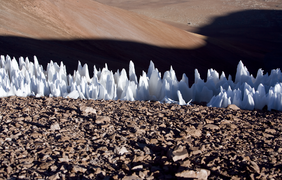Earth:Penitente (snow formation)

Penitentes, or nieves penitentes (Spanish for "penitent snows"), are snow formations found at high altitudes. They take the form of elongated, thin blades of hardened snow or ice, closely spaced and pointing towards the general direction of the sun.[1]
The name comes from the resemblance of a field of penitentes to a crowd of kneeling people doing penance. The formation evokes the tall, pointed habits and hoods worn by brothers of religious orders in the Processions of Penance during Spanish Holy Week. In particular, the brothers' hats are tall, narrow, and white, with a pointed top.
These spires of snow and ice grow over all glaciated and snow-covered areas in the Dry Andes above 4,000 metres (13,000 ft).[2][3][4] They range in length from a few centimetres to over 5 metres (16 ft).[4][5]
First description
Penitentes were first described in scientific literature by Charles Darwin in 1839.[6] On March 22, 1835, he had to squeeze his way through snowfields covered in penitentes near the Piuquenes Pass, on the way from Santiago de Chile to the Argentina city of Mendoza, and reported the local belief (continuing to the present day) that they were formed by the strong winds of the Andes.
Formation
Penitentes are tall, thin blades of hardened snow sculpted by the sun. As the sun hits the snow, it transforms it directly into vapor without melting it, through a process called sublimation. The ice vaporizes without turning into a liquid first. Initially smooth, the snow surface thus develops depressions, hills, and hollows as some regions sublimate faster than others. As the carved surfaces then continue to concentrate the sunlight, they help to speed up the process. This results in icy snow columns that look like towering spikes.[7] Louis Lliboutry noted that the key climatic condition behind the differential ablation that leads to the formation of penitentes is a dew point that remains below freezing. This combined with dry air will cause snow to sublimate. A mathematical model of the process has been developed by Betterton,[8] although the physical processes at the initial stage of penitente growth, from granular snow to micropenitentes, still remain unclear. The effect of penitentes on the energy balance of the snow surface, and therefore their effect on snow melt and water resources has also been studied.[9][10]
Non-terrestrial
Penitentes up to 15 metres (49 ft) high are suggested to be present in the tropics zone on Europa, a satellite of Jupiter.[11][12] According to a 2017 study, NASA's New Horizons mission discovered penitentes hundreds of meters high on Pluto, likely composed primarily of methane ice deposited seasonally from Pluto's thin atmosphere.[13][14] The structures occupy a region named Tartarus Dorsa, a name that was formally accepted by the IAU in August 2017.[15]
Gallery
-
Small penitentes in the summit crater of Mount Rainier.
-
Penitentes ice formations at the southern end of the Chajnantor plain in Chile .
-
Penitentes near the summit of the Agua Negra Pass on the border between Chile and Argentina.
See also
- Hoar frost
- Rime ice
- Stone Forest
- Suncup (snow)
References
- ↑ "Penitentes ESO Australia". https://www.eso.org/public/australia/images/uhd_01_aec_166/?lang.
- ↑ Lliboutry, L. (1954a). "Le Massif du Nevado Juncal ses penitentes et ses glaciers". Revue de Géographie Alpine 42 (3): 465–495. doi:10.3406/rga.1954.1142.
- ↑ Lliboutry, L. (1954b). "The origin of penitentes". Journal of Glaciology 2 (15): 331–338. doi:10.1017/S0022143000025181. Bibcode: 1954JGlac...2..331L.
- ↑ 4.0 4.1 Lliboutry, L. (1965) (in fr). Traité de Glaciologie, Vol. I & II. Paris, France: Masson.
- ↑ Naruse, R.; Lieva, J.C. (1997). "Preliminary study on the shape of snow penitents at Piloto Glacier, the Central Andes". Bulletin of Glacier Research 15: 99–104.
- ↑ Darwin, C. (1839). Journal of researches into the geology and natural history of the various countries visited by H. M. S. Beagle, under the command of Captain Fitz Roy, R.N., 1832 to 1836. London, UK: H. Colburn.
- ↑ "The Penitentes, Stunning Snow Formations". https://www.gessato.com/the-penitentes-stunning-snow-formation-in-the-andes/.
- ↑ Betterton, M.D. (2001). "Theory of structure formation in snowfields motivated by penitentes, suncups, and dirt cones". Physical Review E 63 (5): 12. doi:10.1103/physreve.63.056129. PMID 11414983. Bibcode: 2001PhRvE..63e6129B.
- ↑ Corripio, J.G. (2003). Modelling the energy balance of high altitude glacierised basins in the Central Andes (PhD. thesis). Edinburgh, UK: University of Edinburgh. pp. 151. http://www.uibk.ac.at/geographie/personal/corripio/publications/corripiophd.pdf. Retrieved 7 September 2013.
- ↑ Corripio, J.G.; Purves, R.S. (2005). "Surface Energy Balance of High Altitude Glaciers in the Central Andes: the Effect of Snow Penitentes". in de Jong, C.; Collins, D.; Ranzi, R.. Climate and Hydrology in Mountain Areas. London, UK: Wiley & Sons. pp. 18. http://www.meteoexploration.com/andeswater/andes_jgc_rsp.pdf. Retrieved 7 September 2013.[yes|permanent dead link|dead link}}]
- ↑ "Jupiter moon may have huge, jagged ice blades that complicate the search for alien life". https://www.nbcnews.com/mach/science/jupiter-moon-may-have-huge-jagged-ice-blades-complicate-search-ncna918156.
- ↑ "Europa's surface may be covered by blades of ice". Physics Today. 2013. doi:10.1063/PT.5.027459. http://scitation.aip.org/content/aip/magazine/physicstoday/news/news-picks/europa-s-surface-may-be-covered-by-blades-of-ice-a-news-pick-post. Retrieved 2017-09-28.
- ↑ Talbert, Tricia (2017-01-04). "Scientists Offer Sharper Insight into Pluto's Bladed Terrain". NASA. https://www.nasa.gov/feature/scientists-offer-sharper-insight-into-pluto-s-bladed-terrain/.
- ↑ Moores, John E.; Smith, Christina L.; Toigo, Anthony D.; Guzewich, Scott D. (2017-01-12). "Penitentes as the origin of the bladed terrain of Tartarus Dorsa on Pluto". Nature 541 (7636): 188–190. doi:10.1038/nature20779. PMID 28052055. Bibcode: 2017Natur.541..188M.
- ↑ "Tartarus Dorsa". 2017-08-08. https://planetarynames.wr.usgs.gov/Feature/15679.
Further reading
- Bergeron, Vance; Berger, Charles; Betterton, M. D. (2006). "Controlled Irradiative Formation of Penitentes". Physical Review Letters 96 (98502): 098502. doi:10.1103/PhysRevLett.96.098502. PMID 16606324. Bibcode: 2006PhRvL..96i8502B.
- Kotlyakov, V. M.; Lebedeva, I. M. (1974). "Nieve and ice penitentes, their way of formation and indicative significance" (in de). Zeitschrift für Gletscherkunde und Glazialgeologie X: 111–127. (Describes appearance and formation of these ablation features, with reference to those observed in eastern Pamir, U.S.S.K.)
- Lliboutry, L. (1998). "Glaciers of the Dry Andes". Satellite Image Atlas of Glaciers of the World. USGS-p1386i. http://pubs.usgs.gov/prof/p1386i/index.html. Retrieved 2006-10-25.
External links
- "Spiky glaciers are slower to melt", New Scientist (March 7, 2007).
 |





